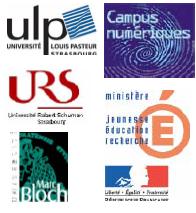Welcome to the Virtual Education Wiki ~ Open Education Wiki
Campus Numériques Français
The Ministry for National Education and Research in France launched three calls in 2000, 2001 and 2002 in order to spread the use of ICT. The first and second calls concerned distance training offers, the third call included a specific measure for new working environments (7 % of total projects). The objective was to build a quality open distance training offer that would be structured in a national network able to compete internationally. In April 2003, almost 400 partners had joined forces in consortia to create 64 labeled digital campuses, in addition to four more campuses dedicated to ENT (environnements numériques de travail = digital working environnements). Therefore this program financed : the creation of training materials, the quality and relevance of dissemination channels, the setting of remote tutoring and support services, the organization of face-to-face meetings.
A digital campus was defined as a training system composed of innovative services, via digital technologies, and that is focused on the learner. It gives access to a training from any place (close or remote), at any time of his/her life (lifelong) and at a rhythm chosen by the learner. The interconnections between participating institutions and the possibility of opening up to public/private or international institutions helped improve the quality of materials and services offered.
Final evaluation of the program
Synthèse finale available only in French !
The training system met the learners' expectations and their overall satisfaction level was very promising. From the learners' point of view, the main asset was to have at their disposal efficient collaborative working tools. Part of the evaluation aimed to assess the system's efficiency, the overall impact and effects and the program's added value.
It resulted that both the impact on their own institutions and their integration were limited because :
- the online training offers were in great part existing courses and only half of them (81) were proposing a degree;
- most of the existing services strongly contributed to the projects, especially the ICT or multimedia departments, whereas the implication of technical and and administrative sevices was variable and sometimes insufficient;
- the planning in producing digital materials (highest category in expenditures) seems to require some improvements;
- the overall organization of the system should be improved, especially the lack of staff, due to high operating costs (in average, each project mobilizes 45 staff members).
NB : Half part of the budget was roughly shifted as follows :
- 39% for digital resources production;
- 15% for coordination, support, pedagogics, technical logistics, training course design;
- 2% for resource purchase (this low rate implies a strong involvement and mobilization of internal production teams).
By contrast, some very positive aspects came out of these initiatives :
- strong participation of teachers in design and production of materials;
- recognition of ICTE and development of related skills and competences;
- project-based operative functioning and creation of an ad hoc steering and coordination structure (critical success factor);
- contribution to setting up the “LMD scheme” by reinforcing modularity, flexibility and individualization of programs in * accordance with the ECTS;
- opening-up towards international projects in the field of e-learning, especially at the European level that may benefit from European funds
Example of a Campus numérique initiative
| UNIVERSITE NUMERIQUE DE STRASBOURG | |
 |
In 2000, all 3 universities of Strasbourg – Université Louis Pasteur (ULP),Université Marc Bloch (UMB) and Université Robert Schuman (URS) – gathered in a consortium to launch a common enhancement policy of ICT in education. On 15 April 2002, all 3 Presidents signed an agreement (l’accord-cadre UNS) to build their cooperation on 3 strategical focuses : creation, dissemination and storage/management of both contents and new pedagogics. In this framework the Université Numérique de Strasbourg offered : – trainings in Computer sciences : networks and systems, digital development, multimedia design – distance trainings with 6 available modules, 6 recognised degrees and 7 under construction |
The second phase of Campus Numériques Français was launched in March 2002 and consisted of a call for proposal on ENTs (digital workspaces). The aim was to offer HEIs a range of varied technological solutions related to ENTs. The “environnement numérique de travail” is a platform to provide HEIs users with online access to all resources, services and digital tools connected with their activities. It has the appearance of a personalized desktop portal.
The overall budget amounted to 3 million € and was split between four selected consortia : ENCORA, EPPUN, ESUP and MONTE-CRISTO.
In April 2005, the submitted projects were evaluated in line with the recommendations of the Ministery's outline plan for ENTs (SDET: Schéma Directeur des Espaces Numériques de Travail) and the conventions betweetn the government and the consortia, on the following aspects : functional coverage, project's organization, deployment, technical architecture of the solution.
CONCLUSIONS:
- Organisation and management : the project teams were efficient and well-integrated in their institution, moreover they managed strictly resources and time schedules, however the resources specifically committed to the projects were poor and the strategical cross-institutional coordinating structures rare;
- Solution development : the SDET's operational and technical recommendations were respected and a good functional documentation was provided;
- Project's finances : all the projects respected the budgets they were initially allocated although very few foresee future financing opportunities;
- Functional coverage : despite the lack of a maintenance strategy, the coverage of services was effective and respected the SDET;
- Technical architecture : although the SDET's recommendations were respected, the quality of service was not enough shaped and formalized;
- Deployment : a stabilization period is necessary in order to integrate the new solutions to the existing context, and despite the lack of precise indicators, some preliminary actions were taken (information, training) as well as some user profiles were previously set up (students, teachers...).